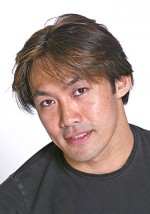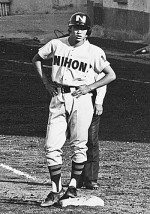Column Name
Title
Subhead
This is an adaptation of an article that originally appeared on Musical America Worldwide. Rachel Straus is Musical America’s dance critic and teaches dance history at Juilliard.
Body
Takehiro “Take” Ueyama (Diploma ’95, dance) fell in love with baseball as a boy growing up in Tokyo, but when his team didn’t make it to the Big Time, he knew he had to find another passion. Thinking he was signing up for lessons in break dancing, he ended up in a modern dance class, where a visiting choreographer ignited an entirely unexpected passion. After supporting himself as a bartender, he moved to New York, aced the audition for Juilliard, and ended up dancing with Paul Taylor (B.S. ’53, dance) for eight years. Now, the 47-year-old choreographer has his own troupe, TAKE Dance, to essay his big, bold, East-meets-West style. Here, Ueyama describes how 13 years of playing baseball helped shaped his artistic vision.
Tell me about your life as a baseball player.
I played from the time I was 4. Every Japanese boy wants to become a professional baseball player. I was pretty lucky, because I had the right physique and I could run fast. I got very serious about it; from age 13 to 16, I trained every day—for hours and hours.
By the time I was 17, I was on a high school team that had played against about 200 teams, one from each region of Japan. We qualified for the quarter finals of the national league championships at Koushien. It’s a big event—the gateway to a professional career—and about 50,000 people attend. It’s even televised.
My position was shortstop, which requires a lot of throwing, and my shoulder had started bothering me. I knew it might one day stop me from continuing to play, but I didn’t focus on that. I just wanted my team to win so we could get into the nationals. When we lost, we all cried so hard, because we knew we weren’t going to play baseball together ever again. Many of us had grown up together.
Did you ever think you’d take up dancing?
Not really. I knew I needed to find something I felt passionate about, since I had stopped playing baseball. I found a job as a bartender in Ginza, one of the most expensive areas in Tokyo. After Michael Jackson’s song Billie Jean came out, kids in Japan started break dancing. [Take would have been about 17 at the time.] I remember imitating Jackson doing the moonwalk. My friends and I would meet in the street and copy, improvise, and invent moves. One day I saw that a class called “New York Dancing” was being offered at a studio run by Tatsuo Mochizuki [Diploma ’81, dance]. I thought Tatsuo was going to teach break dancing, but he taught New York modern dance, such as the Martha Graham [faculty 1951-77] and José Limón [faculty 1951-72] techniques. [Mochizuki was a onetime member of the Kansas City Ballet.]
I didn’t like modern dance or ballet, and the first day I wore tights was awful, but I kept on going to Tatsuo’s classes because he was interesting. He had a great sense of humor. He took me to artists’ hangouts and bohemian spots, places unknown to regular Japanese people.
What made you fall in love with dancing?
I took two classes a week with Tatsuo for about five years. I was probably one of the most frustrated dancers in his studio because at the time, Japanese male dancers looked to Nureyev and Baryshnikov as models. I admired them, but ballet wasn’t for me.
Then, when I was about 19 years old, [Graham-based choreographer] Kazuko Hirabayashi (Diploma ’62, dance; faculty 1968-2011) gave a workshop at Tatsuo’s studio. Taking Kazuko’s class shocked me. Her movement went through my spine like an electric jolt. I felt a deep connection with her speed, her dramatic style. I fell in love. I began to get serious about dance. When Kazuko came back to Tatsuo’s studio a year later, I told her that I didn’t fit in with the Japanese dance scene. Kazuko said, “Why don’t you come to New York?”
So I did, just to study with her. She suggested I also study ballet with Alfredo Corvino [faculty 1953-94], so I took two of his classes every day, Monday through Friday, that entire summer.
How old were you when you finally auditioned for Juilliard?
I was 24. Kazuko really prepared me for it. At the audition, I spoke no English, so I couldn’t communicate. I couldn’t fill out my application form. But I got it in! Kazuko smoothed the way. She is like a mom to me.
Can you point to a single moment where you knew your life had changed?
My life changed the day I left Tokyo to start my education at Juilliard. From the Narita International Airport, I took a plane bound to New York. I knew I wouldn’t be coming back to Japan. From the airport tarmac, I could see my family waving from the terminal window. They were crying. At that moment, I realized I had to do something important with my life. I couldn’t just go to New York to have fun. Those tears from my family were huge for me.
When did you become interested in Paul Taylor’s choreography?
My third year at Juilliard, I danced in Taylor’s Esplanade (1995). Every time we rehearsed the piece with Linda Kent [(B.S. ’68, dance; faculty 1984-present), a onetime Taylor dancer], I was so happy. I thought, “Oh my God, if I can dance this all the time, I’m going to be the happiest person ever.” Esplanade came naturally to me because of baseball. There are these huge slides in it. When Linda first introduced us to the slide section, I was running like a baseball player. Today, I use a lot of slides in my repertoire. People think they are from Taylor, but they’re not. My slides are from baseball.
After eight years dancing with Paul Taylor, I realized that I wanted to be like him. Taylor controls everything: he makes his own dances and works with dancers of his choosing. The year I left the company, I choreographed my first work. I was 35 years old. Two years later I founded TAKE Dance.
What is the major difference between baseball and dancing?
In sports, you either win or lose. It’s never good to make a mistake in a dance work, but that doesn’t mean that it won’t be performed right the next night. In baseball, your mistake can cost the team the game.
What has been your family’s reaction to your dance career?
My parents have always let me do whatever I wanted to do. They never questioned my direction. When I performed in China with the Taylor company, my father and brother came to see me dance. My father boasted to his friends about me. After I left for New York, my mother opened her own business [a Karaoke bar]. She felt inspired by my independence.
Copyright © 2014, Musical America. Used by permission.






